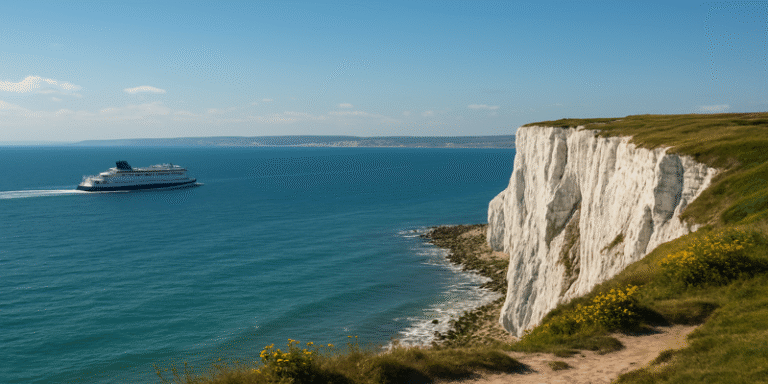The English Channel, a narrow arm of the Atlantic Ocean, stretches approximately 560 kilometres from the Atlantic near Land’s End in Cornwall to the Strait of Dover, separating southern England from northern France. Far from being just a body of water, the Channel plays a vital role in shaping geography, history, culture, economy, and the environment on both sides of its coastlines. Often overlooked in favour of more dramatic landmarks, the English Channel is nonetheless a crucial geographical feature with an enduring significance in European civilisation.
Geography and Strategic Significance
The English Channel’s geographic position makes it one of the most critical sea routes in the world. At its narrowest point—the Strait of Dover—the Channel is only 34 kilometres wide, and on clear days, one can see the cliffs of France from the White Cliffs of Dover. Geologically, the Channel was formed at the end of the last Ice Age through massive flooding from glacial lakes, which carved the existing seabed and separated Britain from mainland Europe (Gibbard & Cohen, 2008).
This proximity made the Channel a natural frontier, protecting England from numerous attempted invasions throughout history, including the Spanish Armada in 1588 and Napoleon’s unrealised campaign in the early 19th century (Clayton, 2008).
Historical Importance
The English Channel has long been a conduit of both conflict and collaboration. It has witnessed Roman invasions, Viking raids, and Norman conquests. Most notably, it was the staging area for D-Day during World War II in 1944, when Allied forces crossed from England to Normandy in what remains the largest seaborne invasion in history (Keegan, 1982).
Beyond warfare, the Channel has facilitated trade and cultural exchange for centuries. From the Medieval wool trade to the modern tourism industry, the Channel has been central to cross-Channel relations. Even with Brexit, this waterway continues to represent a symbolic and literal bridge between the UK and continental Europe.
Economic Lifeline
As one of the world’s busiest maritime corridors, the English Channel handles over 500 ships daily, including cargo, tankers, and passenger vessels (UNCTAD, 2021). It is vital for the UK’s logistics, import-export industry, and energy infrastructure. Key ports like Dover, Portsmouth, Southampton, Calais, and Cherbourg play pivotal roles in facilitating these operations.
The Channel is also essential for the fishing industry, although tensions have flared in recent years between British and French fleets over territorial access (BBC News, 2021). These disputes highlight the Channel’s continued relevance in international relations and economic diplomacy.
Tourism and Cultural Appeal
With its historic towns, iconic landmarks, and stunning coastal scenery, the English Channel region is a major tourist destination. The Jurassic Coast in Dorset, a UNESCO World Heritage Site, attracts visitors for its dramatic cliffs and fossil-rich rocks (UNESCO, 2023). On the French side, picturesque towns like Étretat and Saint-Malo combine natural beauty with cultural depth.
The Channel also hosts one of the most gruelling endurance challenges in the world: the English Channel Swim. Swimmers attempt to cross the treacherous waters between Dover and Calais—a feat requiring not only physical stamina but also significant logistical support. The event has become a symbol of human resilience and draws international attention (Baysal et al., 2025).
Environmental Concerns
The ecosystem of the English Channel is rich and diverse, supporting numerous species of fish, marine mammals, and seabirds. However, it is also under pressure from overfishing, marine traffic, and pollution. The Channel has seen frequent incidents of oil spills and plastic waste accumulation, which threaten its fragile marine biodiversity (Marine Conservation Society, 2022).
Climate change poses another major threat. Rising sea levels and increased storm frequency have accelerated coastal erosion, particularly along the southern English coastlines (DEFRA, 2023). Conservation efforts such as marine protected areas and cross-border environmental agreements are now vital in preserving the Channel’s future.
Engineering Marvels and Human Innovation
One of the most remarkable feats of engineering associated with the English Channel is the Channel Tunnel (Eurotunnel). Completed in 1994, it connects Folkestone in the UK with Coquelles in France via a 50.5-kilometre rail tunnel under the seabed. It is the longest undersea tunnel in the world and has significantly enhanced cross-border travel and trade (Shaw, 2001).
The tunnel also represents a symbolic commitment to European cooperation. Despite political tensions, infrastructure like the Eurotunnel continues to underpin mutual economic and cultural interests.
Cultural and Literary Imprint
The English Channel has found its place in literature, music, and cinema. From Shakespeare’s King Lear referencing the “cliffs of Dover” to modern novels and travel writing, the Channel is embedded in the European cultural psyche. In art and literature, it often serves as a symbol of separation or connection, depending on the historical moment.
Charles Dickens frequently used the Channel coast as a backdrop for his novels, reflecting both the beauty and peril of sea travel in the 19th century. More recently, travelogues and documentaries continue to explore the Channel’s mystique and ongoing relevance.
Contemporary Issues and Future Outlook
In the 21st century, the English Channel has also become a humanitarian concern. Thousands of refugees and migrants have attempted to cross the Channel in small boats, fleeing conflict or poverty in search of asylum in the UK. The route, perilous due to tides and shipping lanes, has seen tragic accidents and prompted fierce debates over immigration policy and border control (The Guardian, 2023).
These developments underscore the Channel’s role not just as a geographic entity but as a stage for global human struggles. Policies on migration, maritime safety, and international cooperation will determine how this challenge evolves in the coming years.
The English Channel is far more than a strip of water—it is a living historical archive, an economic artery, a tourist magnet, and an environmental challenge. From Norman conquests to Eurostar journeys, from cliff-top hikes to refugee rescues, the Channel continues to shape the lives of millions.
Its enduring importance rests not just on its strategic location but on the ways in which nations have adapted to and interacted with it. Whether as a barrier or bridge, the English Channel remains central to understanding the past, present, and future of Britain, France, and Europe.
References
Baysal, D., Eminoğlu, E., Çalış, N., & Vanlı, A.S. (2025). Comparison of the World’s longest swimming marathons in terms of economic benefits and destination potential: The case of Yumurtalık-Iskenderun, Turkey. Turkish Journal of Maritime and Oceanic Management. [Available at: https://www.tujom.org/index.php/1/article/view/209].
BBC News. (2021). UK and France clash over Channel fishing rights. [Available at: https://www.bbc.com/news/uk-59064427].
Clayton, T. (2008). Trafalgar: The Men, the Battle, the Storm. Hodder & Stoughton.
DEFRA. (2023). Coastal erosion and climate impacts in Southern England. [Available at: https://www.gov.uk/government/publications].
Gibbard, P.L. & Cohen, K.M. (2008). Global chronostratigraphical correlation table for the last 2.7 million years. Episodes, 31(2), pp.243-247.
Keegan, J. (1982). Six Armies in Normandy: From D-Day to the Liberation of Paris. Penguin.
Marine Conservation Society. (2022). English Channel marine pollution report. [Available at: https://www.mcsuk.org].
Shaw, J. (2001). The Channel Tunnel: Twenty-first century infrastructure. Journal of Transport Geography, 9(4), pp.255–263.
The Guardian. (2023). Deaths in the English Channel highlight refugee policy failures. [Available at: https://www.theguardian.com/world/channel-crossings].
UNESCO. (2023). Jurassic Coast World Heritage Site. [Available at: https://whc.unesco.org/en/list/1029].
UNCTAD. (2021). Review of Maritime Transport 2021. [Available at: https://unctad.org/webflyer/review-maritime-transport-2021].









